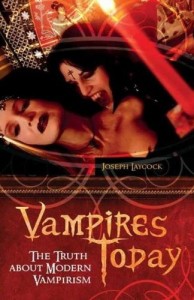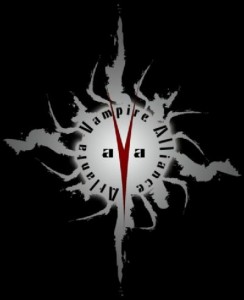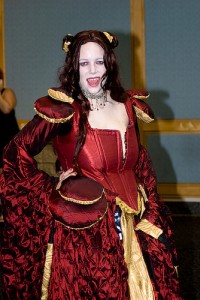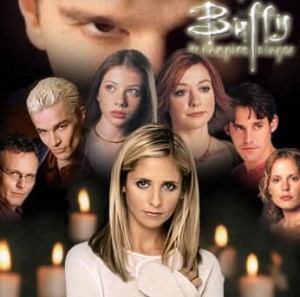 For quite some time the vampire has been an important figure in popular culture. While the zombie has been a rival in recent decades as a monstrous icon, the vampire seems to be making a comeback as the increasing number of books, films, and television programs featuring this figure indicate.
For quite some time the vampire has been an important figure in popular culture. While the zombie has been a rival in recent decades as a monstrous icon, the vampire seems to be making a comeback as the increasing number of books, films, and television programs featuring this figure indicate.
I recently finished reading a new book that explores those who adhere to the vampire identity, Vampires Today: The Truth About Modern Vampirism (Praeger, 2009), by Joseph Laycock. Laycock is an independent scholar and doctoral candidate studying religion and society at Boston University. I spoke with him recently about his new book.
TheoFantastique: Joseph, thank you for your fine book on an interesting topic. It was a great read and a good piece of scholarship. I’d like to begin our discussion on a personal note. How did the subject of vampires become of interest to you as a research project with your religious studies background?
Joseph Laycock: Vampires are an interesting preoccupation. A personal interest in vampires tends to achieve a greater level of intensity than other types of interests. For instance, I consider myself a “coffee buff” because I own my own grinder. But prior to writing this research, I could not really have called myself a “vampire buff.” I had read a few Anne Rice novels, I enjoyed the occasional vampire movie, and I knew who Bela Lugosi was. But compared to a serious vampire enthusiast I was a poser at best. I had never even seen Buffy: The Vampire Slayer.
Like most people I began with a dim awareness that somewhere in the world there were people who considered themselves vampires. Then in 2006, I began listening to a podcast called Shadowdance. I am interested in popular religion, including esoterica and “new religious movements.” The podcast discusses these areas from the perspective of a practitioner and is really very thought provoking. After listening for a few months, one of the hosts (Michelle Belanger) did a show about her identity as a vampire. She also mentioned a research project that was currently being conducted by the Atlanta Vampire Alliance (AVA). I was living in Atlanta at the time and I decided to contact the AVA. They were friendly but cautious and I began to learn more about their work.
 TheoFantastique: In the Preface of your book you define several important terms. These include “real vampire,” “the vampire milieu” and “the vampire community.” Can you define these and talk a little about why they are important to understanding contemporary vampires?
TheoFantastique: In the Preface of your book you define several important terms. These include “real vampire,” “the vampire milieu” and “the vampire community.” Can you define these and talk a little about why they are important to understanding contemporary vampires?
Joseph Laycock: The terms “real vampire” and “vampire community” are commonly used by within vampire culture. When someone says that they are a “real vampire,” they do not mean that they are actually undead or immortal. Rather, this term is used in contradistinction to “lifestyle vampires.” Lifestyle vampires or “lifestylers” are usually dedicated fans of vampire fiction and enjoy dressing as the undead. Real vampires believe that they are somehow biologically or metaphysically distinct from other people. The key difference is that lifestylers choose their identity while real vampires see their identity as a vampire as essential and unchangeable.
The term “vampire community” (often just “VC” in Internet communications) is a broad label that generally includes anyone who identifies as a vampire. Many different and conflicting ideas of vampirism coexist with the vampire community. Although formal groups exist within the community, it is not an organization or institution. It functions more as an identity group that all vampires are ascribed to. Vampires typically speak about the vampire community in much the same way that gays speak about the gay community or African-Americans speak about the black community.
The term “vampire milieu” was coined for the book and was not commonly used by any vampires I met during my study. Our culture has an evolving pool of ideas about vampires and self-identified vampires reference this milieu to express their identities. To understand real vampires, you have to study the archetypes they are referencing. Confusion arises because popular culture has turned vampires from vile animated corpses to a sort of alluring super-hero. The vampire milieu also includes occult writings about vampires, and theories of holistic health. Vampires may draw on any of this material in forming and describing their ideas. One model of vampirism is often quite different from another, but there remains a sort of family resemblance arising from the vampire milieu.
It is also useful to note that the vampire milieu and the vampire community are distinct entities. For example, vampires that “sparkle in sunshine” are now entrenched within the vampire milieu. However, (as far as I know) the vampire community has had little to do with this trope. This distinction is also important to any discussion of vampires and crime. Occasionally, the criminally insane will develop an obsession with the vampire milieu. One individual believed that an Anne Rice character ordered him to murder a friend. However, it is very rare that these individuals participate in the vampire community: While they may call themselves a vampire, they are not in communication with other self-identified vampires. I have found only two cases where such a criminal did not act alone and may have had contact with the vampire community.
TheoFantastique: Most people might assume that all vampires consume blood due to the images we have picked up from folklore, cinema, and television. You discuss several different types of vampire experience. Can you briefly sketch these?
Joseph Laycock: The distinction between lifestylers and real vampires has already been discussed. Real vampires generally claim that they must “feed” in order to maintain their physical, mental, and spiritual health. Some real vampires, known as sanguinarians, feed on blood. This usually consists of small quantities taken from human donors. Psychic vampires do not drink blood but rather “feed” on the vital energy of those around them. Psychic vampirism has been part of occult literature at least since the 19th century. The idea that some people either borrow or take the energy of others is common throughout Asia and the Theosophical Society used this idea to re-imagine the Western idea of the vampire. There are also “hybrid” vampires who consume both blood and psychic energy.
Finally, I find it useful to make a distinction between the “awakened” and “initiatory” models of vampirism. The majority of real vampires believe that you cannot be “turned” or otherwise choose to become a vampire. Instead they believe that vampirism is an essential identity inherent from birth. The process of discovering one’s identity as a vampire is known in the community as “awakening.” However, there are several groups who view vampirism as a sort of apotheosis to be undertaken through ritual initiation. These groups tend to be associated with the Church of Satan and similar “left hand path” occult movements. There has been tension between the two models over what a “real vampire” actually is. However, some recent overtures have been made towards reconciliation.
TheoFantastique: What are some of the ways in which contemporary vampire identities have been explained?
Joseph Laycock: The modern vampire community has been attributed to porphyria and other diseases, fantasy-prone personality, narcissistic personality disorders, pica (a mental illness characterized by eating dirt, plaster and other inedible substances), and sexual fetishism. It has also been described as an organized and dangerous cult. In sociological terms, the vampire community is a “deviant” group: Literally, one that deviates from social norms. Historically, one of the most effective ways to exert social control over deviance has been to “medicalize” it, reducing a complex social phenomenon to a listing in the DSM (Diagnostic and Statistical Manual of Mental Disorders). Homosexuality appeared in the DSM until 1974.
The label “cult” is also tied to medicalization. Throughout the 1970s, various counter-cult groups tried to circumvent the first amendment by claiming that some religions practice brainwashing and therefore constitute an “information disease.” Polemical characterizations of the vampire community as a religion tend to present individual vampires as automatons whose identity has been absorbed into a larger movement. Descriptions of luring teenagers into vampire culture through the Internet echo the earlier label of “information disease.” I believe that an explanation of this community must look at the personal narratives of individual vampires as well as the larger social context.
 TheoFantastique: How does the vampire identity help to re-enchant the world in late modernity and how does this fit in with other expressions of re-enchantment?
TheoFantastique: How does the vampire identity help to re-enchant the world in late modernity and how does this fit in with other expressions of re-enchantment?
Joseph Laycock: Sociologists used to believe in what is now called the “myth of universal secularization.” That is, a prediction that the social influence of religion and belief in the supernatural will continue to decline until both become nonexistent. The process of secularization now appears to be cyclical in nature, either because secular movements have inspired a backlash of religiosity or because the decline of traditional churches has left individuals free to explore supernatural belief systems.
The connection between modern vampires and “re-enchantment” was first made by Christopher Partridge. In his theory of re-enchantment, Partridge points out that as traditional religion is declining, new belief systems are proliferating. Furthermore, the distinction between deviant and legitimate religion has begun to narrow. Re-enchantment then argues that religion is not fading away so much as changing. The metaphysics of vampirism, as well as emerging new religious movements and popular occultism are all evidence of this change.
It has been suggested that a purely rationalist-scientific worldview is actually very difficult to maintain and leaves the average person dissatisfied. The anthropologist Lucien Levy-Bruhl once claimed that “primitives” do not think in rational terms but rather experience the world through what he called “mystical participation.” In his posthumous work he reformulated his theory, suggesting that mystical participation occurs in all cultures and is simply easier to observe among primitives. Essentially, human beings are always balancing two different modes of thought. Wouter Hanegraaff has suggested that “disenchantment” can be thought of as the suppression of mystical participation in deference to a rational worldview. From this perspective, the vampire community can be seen as a restoration of this balance. I did not find the vampires to be unable to discern fantasy from reality. Rather they discussed their subjective experiences openly and sought ways to relate these experiences to a rational worldview without dismissing them.
 TheoFantastique: What types of elements have helped to create the vampire milieu?
TheoFantastique: What types of elements have helped to create the vampire milieu?
Joseph Laycock: In my book I attempt to describe the evolution of the vampire milieu chronologically across four areas: Literature, film, and television; occult writing; metaphysical and holistic health; and vampirology. In reality, these areas all blend together. The vampire of Slavic folklore is largely left out because vampires do not actually think of themselves as undead. (For the same reason, Buffy the Vampire Slayer is of little importance to real vampires.) Occult groups such as the Theosophical Society and the Hermetic Order of the Golden Dawn re-imagined the vampire as a being that feeds on subtle energy rather than blood. This set the stage for the modern understanding of psychic vampires. The novel I Am Legend (1954) by Richard Mattheson re-imagined the vampire again as a biological entity. This too influenced the vampire community. It also appears to have influenced the medical community, which has periodically sought to explain vampire legends in terms of known diseases. Finally, with the series Dark Shadows in the 1960s, the vampire became a symbol of tragedy, romance, and alienation. As a deviant hero, Barnabus Collins caused many people to identify with the vampire. Dark Shadows foreshadowed the vampires of Anne Rice and even Edward Cullens.
Metaphysical ideas associated with holistic health have also influenced how vampires see their condition. Western concepts of subtle energy such as mesmerism and the Freudian notion of libido were linked tovampirism in the nineteenth and early twentieth centuries. There is now an interesting dialogue beginning to form between self-identified vampires and practitioners of qigong, reiki, and other health practices from Asia.
The last category, “vampirology” refers to a series of amateur studies on real vampires. This began with figures like Stephen Kaplan who opened a “vampire research center.” However, the most ambitious studies to date have been done by vampires themselves. The AVA has collected data from over 1450 individuals. While the academy can challenge their methodology, it is hard to imagine an outsider conducting a better quantitative analysis of this community. I believe that their findings will ultimately determine what it means to be a vampire. This indicates that the vampire community has begun to exert agency over the milieu.
TheoFantastique: In terms of community, are most vampires solitary or do they seek group interaction, and how has the Internet played a part in this process?
Joseph Laycock: The AVA’s survey indicates that the majority of vampires are not part of any formal organization. However, vampires have always sought group interaction. In the 1980s vampires met through fan conventions for Dark Shadows and horror movies. In the 1990s vampires began communicating through zines and other small print media. The community appears to have been on the Internet for as long as it has existed, first using listserves, then forums, and now peer-networking sites.
The Internet generally has a leveling effect on religions. The Internet has not been kind to hierarchical religious organizations such as the Catholic Church or Scientology. On the other hand, non-hierarchical religions such as Paganism have flourished online. Initiatory religious groups such as the Temple of the Vampire seem to have been hurt by the transition to the Internet. The Vampire Bible and other copyrighted texts have been disseminated to the uninitiated online. By contrast, the awakened model of vampirism has flourished as many individuals have begun to rethink their identity after encountering the vampire community online.
The Internet has also brought many young people to the vampire community. More experienced vampires have tried to help by posting articles or even creating “checklists” for individuals who suspect they might be a vampire. The latest innovation is a series of youtube clips where vampires answer questions e-mailed to them about vampirism.
TheoFantastique: Several new religions scholars have considered vampirism a new religious movement? Is vampirism a religion?
Joseph Laycock: The answer to this question depends on which model of vampirism is under consideration and what criteria of religion are being used. The vampire community runs a gamut from The Temple of the Vampire which claims to have legal recognition as a church to atheists who believe vampirism will one day be understood by medical science.
Certainly groups like the Temple of the Vampire are new religious movements. However, I have argued against categorizing the entire vampire community as a new religious movement. One reason being that a significant percentage of vampires describe themselves as Christian. Although vampirism is frequently explained in terms of metaphysical or supernatural beliefs, it appears that many vampires see their identity as a vampire as distinct from their religious affiliation.
TheoFantastique: What types of reception have vampires received as they have become more above ground?
Joseph Laycock: In the United States, this varies greatly from region to region. In the Bible Belt, vampires are very cautious about keeping their identity a secret. I heard a story of at least one vampire who was “outed” to his community and asked to leave his church. By contrast, identifying as a vampire may not seem all that unusual in Los Angeles.
As the media seeks to capitalize on the current fascination with vampires, the vampire community has received an unprecedented level of attention. The AVA is contacted by a new television show or documentary about every month. Community leaders have been very active in monitoring this attention and curbing sensationalism. For instance, the show Trading Spouses was unable to find a vampire who would appear on their show. I believe that there has been a gradual shift from very sensationalistic coverage of the community (usually around Halloween) to more nuanced portrayals of vampires. By the same token, Vampires Today is not intended as a definitive text on this community. Rather, I hope to encourage further research on vampires and other emerging identity groups and suggest further areas of inquiry.
TheoFantastique: Joseph, thanks again for your research in this area, and for your willingness to discuss your book. I wish you the best in your continued academic studies and work.





Very interesting. As a Hybrid I enjoyed this read Very much. Thank you for posting this. This is a recomended book my our Coven, I suggest those who want to know on Vampirism to order or pick this book up.
Darkest Blessings, Dez
*Chuckles* Hybrid? Vampires are hybrid… Human counterparts. Please read up and study definitions before stereotyping the self into any specific category.
The information provided within this interview is not to be taken as a be all end all on vampirism by any means.
House Solaris Admin
Excellent article,
Joe seems to be one of the most interesting individuals and truly a Black Swan of the Vampyres. Eternally,
Mael, Sanguinarium Administrator.
I haven’t read this book yet, and even with this, almost feel un-comfortable knowing that someone NOT of our community has taken it upon himself to write a book “outing” us. I do agree with the all the previous comments here thought. The author seems of very sound mind and perhaps had/had good intentions, but we all know where that leads. Yes, this text should not be all that defines the VC, but again I’m not fond of all the media attention, we are not a spectacle. Our bigger more well-known names and groups within the community seem to thrive on the attention they can heap on the rest of us by encouraging participation in projects, such as this one.
I haven’t read this book yet, and even with this, almost feel un-comfortable knowing that someone NOT of our community has taken it upon himself to write a book “outing” us. I do agree with the all the previous comments here though, to some extent. The author seems of very sound mind and perhaps has/had good intentions, but we all know where that leads. Yes, this text should not be all that defines the VC, but again I’m not fond of all the media attention, we are not a spectacle. Our bigger more well-known names and groups within the community seem to thrive on the attention they can heap on the rest of us by encouraging participation in projects, such as this one.
I always enjoy articles like this. I wear a bit of my identity everywhere because it is who I am, and while most people just shrug it off, I’m reminded that many consider the Vampire evil. It’s always nice when someone can put a rational spin on the subculture.
how true is the vampire?until now do vampire exist?in what country they are active until now?i think vampire is only a “hersay” a false belief from old world…
As a writer and member of the Vampire Voices Council, I read Mr. Laycocks book with a certain distance in mind in an attempt to keep an open mind. Of course someone not being directly involved in the community will not have the same sensitivity, yet the author does not only impart a detailed history but treats the participants in a compassionate manner that was a plesant and welcome relief.
I not only enjoyed his work, but advise anyone wnating to know the subculture to give it a study before venturing into the online world deeply, as it will familiarize them before hand.
Corvis Nocturnum
Author of: Embracing the Darkness; Understanding Dark Subcultures, and most recently, Allure Of The Vampire; Our Sexual Attraction To The Undead.
I think Laycock should be participating in the Nurel forum!